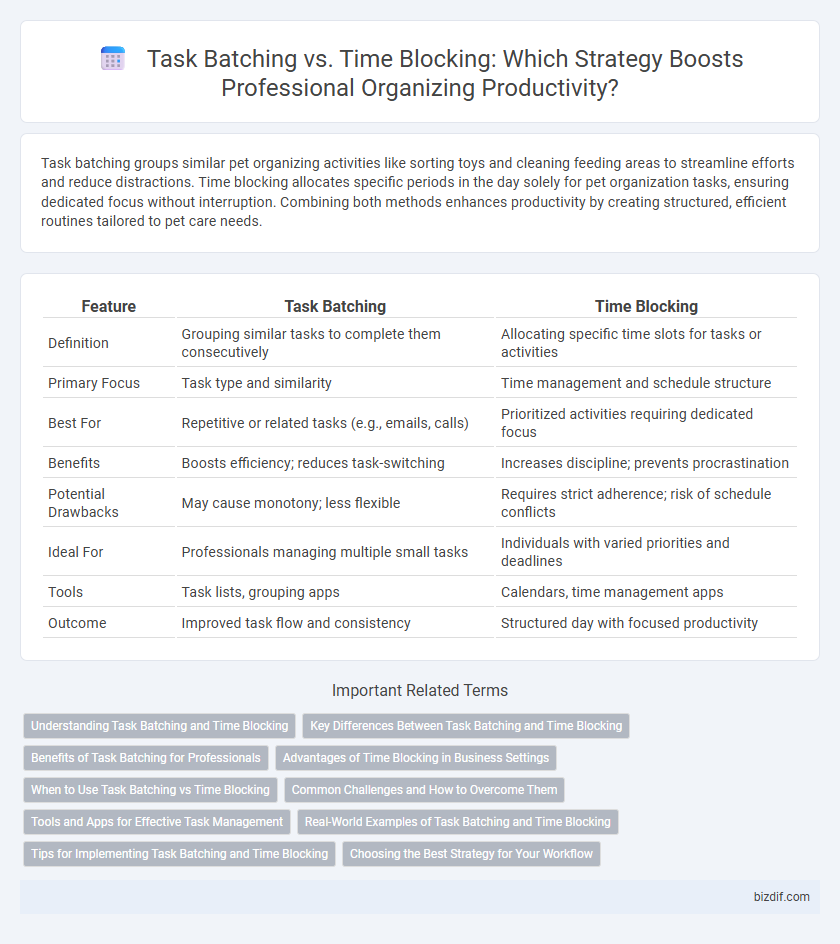Task batching groups similar pet organizing activities like sorting toys and cleaning feeding areas to streamline efforts and reduce distractions. Time blocking allocates specific periods in the day solely for pet organization tasks, ensuring dedicated focus without interruption. Combining both methods enhances productivity by creating structured, efficient routines tailored to pet care needs.
Table of Comparison
| Feature | Task Batching | Time Blocking |
|---|---|---|
| Definition | Grouping similar tasks to complete them consecutively | Allocating specific time slots for tasks or activities |
| Primary Focus | Task type and similarity | Time management and schedule structure |
| Best For | Repetitive or related tasks (e.g., emails, calls) | Prioritized activities requiring dedicated focus |
| Benefits | Boosts efficiency; reduces task-switching | Increases discipline; prevents procrastination |
| Potential Drawbacks | May cause monotony; less flexible | Requires strict adherence; risk of schedule conflicts |
| Ideal For | Professionals managing multiple small tasks | Individuals with varied priorities and deadlines |
| Tools | Task lists, grouping apps | Calendars, time management apps |
| Outcome | Improved task flow and consistency | Structured day with focused productivity |
Understanding Task Batching and Time Blocking
Task batching involves grouping similar tasks together to minimize context switching and improve focus, while time blocking allocates specific time periods in the calendar for different activities, enhancing time management and productivity. Both techniques help professionals streamline workflows by increasing efficiency and reducing distractions, but task batching emphasizes task similarity whereas time blocking emphasizes scheduling. Implementing these strategies in professional organizing can lead to better prioritization and more effective use of working hours.
Key Differences Between Task Batching and Time Blocking
Task batching groups similar tasks together to enhance focus and reduce transition time, while time blocking allocates specific time periods for different types of activities regardless of their similarity. Task batching minimizes cognitive load by concentrating on related tasks, whereas time blocking emphasizes strict scheduling to ensure dedicated attention to each time segment. Understanding these differences helps professionals optimize productivity by choosing the method that best suits their workflow and task variety.
Benefits of Task Batching for Professionals
Task batching enhances productivity by grouping similar tasks together, reducing cognitive load and minimizing distractions during work periods. Professionals experience improved focus and efficiency, leading to faster task completion and better quality results. This method also decreases the frequency of task-switching, which helps conserve mental energy and maintain sustained concentration throughout the day.
Advantages of Time Blocking in Business Settings
Time blocking maximizes productivity by allocating specific time slots for focused work, reducing distractions and multitasking inefficiencies in business settings. It enhances time management through clear priorities, allowing professionals to handle complex projects and deadlines systematically. Improved workflow and increased accountability result from dedicated periods for meetings, creative tasks, and administrative duties.
When to Use Task Batching vs Time Blocking
Task batching is most effective for handling similar, repetitive tasks that require minimal cognitive shifts, such as responding to emails or processing invoices, improving efficiency by reducing task-switching time. Time blocking works best for complex or high-priority projects that need dedicated focus and uninterrupted periods, like strategic planning or creative work. Use task batching during routine administrative periods and apply time blocking for deep work sessions to optimize productivity.
Common Challenges and How to Overcome Them
Task batching often struggles with interruptions that break focus, while time blocking can be disrupted by underestimated task durations causing schedule overruns. Overcome these challenges by setting clear boundaries for distraction-free periods during task batches and incorporating buffer times within time blocks to accommodate unexpected delays. Utilizing digital tools like calendar apps with reminder features enhances adherence to both methods and improves productivity consistency.
Tools and Apps for Effective Task Management
Task batching tools like Trello and Asana streamline grouping similar activities, boosting focus and efficiency by minimizing task-switching. Time blocking apps such as Google Calendar and Clockify enable precise scheduling of dedicated time slots, improving productivity through structured work periods. Integrating both approaches using platforms like Notion allows seamless task organization and time allocation, enhancing overall task management effectiveness.
Real-World Examples of Task Batching and Time Blocking
Task batching improves productivity by grouping similar activities, such as answering emails in one session or scheduling all phone calls back-to-back, minimizing distractions and transition time. Time blocking involves allocating specific hours for designated tasks, exemplified by reserving 9 AM to 11 AM for focused project work and 2 PM to 3 PM for meetings, providing structure and preventing overcommitment. Companies like Google utilize time blocking to enhance focus, while entrepreneurs often use task batching to streamline daily operations and reduce cognitive load.
Tips for Implementing Task Batching and Time Blocking
Task batching enhances productivity by grouping similar tasks, reducing mental fatigue and transition time. Time blocking allocates specific periods for focused work, minimizing distractions and improving time management. Implement these strategies by prioritizing high-impact tasks during peak energy hours and using digital calendars to enforce dedicated task intervals effectively.
Choosing the Best Strategy for Your Workflow
Task batching improves efficiency by grouping similar tasks to reduce context switching, making it ideal for repetitive workflows. Time blocking assigns specific periods to different activities, enhancing focus and preventing task overlap, which suits varied or unpredictable schedules. Selecting the best strategy depends on workload type, frequency of task changes, and personal productivity preferences to optimize organization and time management.
Task batching vs Time blocking Infographic

 bizdif.com
bizdif.com